Perfect In The Dew
plainsong & pipistrelles
We sit late, watching the dark slowly unfold:
No clock counts this.
When kisses are repeated and the arms hold
There is no telling where time is.
Ted Hughes, ‘September’ (extract)
The season changes along the lane, 3 September 2024.
Hello, and welcome to this September New Moon in Virgo edition of Bracken & Wrack.
This lunchtime I walked along the lane in search of feral Roman fennel (see below) and was struck by the slide into autumn that seems more and more apparent each day. It’s not been a good year for blackberries in general, but certainly there were enough juicy berries in the hedge for me to make a note to myself to come back with my colander soon. But it was the colour change that was the most noticeable thing of all, as the bracken begins to bronze, some of the fronds graphically illustrating this transition with one side of the leaf stem still bright green while the other side has already turned tawny.
Bracken and bramble alike were festooned with golden straw-strands, decorating and animating the hedge banks in harvest finery. The lane is so narrow that the local tractor, bearing aloft a single hay bale like a trophy, still manages to lose a little of its treasure on either side each time it chugs through.
And the seed heads! Jet black clusters of alexanders seeds above brittle stems, thistle heads, teasels, and many others I couldn’t identify. Knapweed for one, maybe.
But it was the dragonflies that held me mesmerised. The lack of pollinators and butterflies this year has been a worry, but dragonflies seem more numerous than I can ever remember. Vibrating, whirring and skimming, weaving a harvest dance from side to side in their dozens in whichever direction you looked.
I’ve read that dragonflies live for up to four years. Almost all of these are spent at the bottom of a pond or stream, before crawling up a reed and breaking free. There’s just time to delight in that joyous September moment of life, sun, air. And, of course, the dance.
Turning to gold, blackberry leaves and fallen straw on the lane, 3 September 2024.
Clear themes seem to have emerged unbidden in recent editions of Bracken & Wrack, but this time I think there’s merely a slightly wistful early September feeling. I decided to include a longer piece than I often do, so there are fewer seasonal snippets. That’s not necessarily the start of something different, just what called to be slipped inside this New Moon issue. So, here we have:
Not Quite Earth & Not Quite Water
Poetry by Ted Hughes & W S Merwin
A Cosy Place To Hibernate
A Particular Devotion
Saint Gregory’s Citrus, Ginger & Fennel Tea
NOT QUITE EARTH & NOT QUITE WATER
Suffolk is like Norfolk used to be when we were children, you say. I can see exactly what you mean. Turning into the gravelled strip that looks directly onto masts and flags glinting in the sun, we scan its length for a sign forbidding us to use the car park if we don’t intend visiting the pub. But apparently there’s no such prohibition; seems we’re welcome. A word with the man just climbing out of the next car confirms that we’re right. So we head for the jingling masts and the shacks with ‘cockles’ and ‘winkles’ in their names.
Is this river or sea? The estuary is, I think, one of the most liminal of all betwixt and between places. The water neither salt nor fresh but a magic potion stirred from both their essences. The technical term ‘brackish’ I always think sounds stagnant and therefore unpleasant. It feels entirely the wrong word for such an enchanted fluid.
We’re planning to travel across the mouth of the Deben from Old Felixstowe to Bawdsey by ferry, but first there’s the riverbank to explore. Although it is indeed a bank, it’s actually a long way from the river, as stretching between the two are mud flats run through with creeks and spiked with tall clumps of wild wayside plants.
It’s a sparkly day. The distant water glitters, the sky is blue and the creeks are quicksilver elvers. The wild edges are flourishing here and I exclaim with delight at the sight of so many species: red clover, meadow grasses, mallow. A narrow tarmac path runs between them. And beyond, on the mud flats, the sight we are here for. Boats.
Some are house boats and clearly lived in, others have seen far better days and are gently sinking into oblivion. But not without radiating a poignant beauty within their decay. Paint flaking, its former vibrant colours now bleached and gorgeous under the late summer sun.
Some are upside down or rocked onto their sides. The shape of a boat, like the shape of a bird, stripped down to its essence is endlessly pleasing to the eye. They both speak to something deep within us, I suddenly realise. Boats and birds: yes, our prehistoric ancestors knew both of these intimately, even when boats were fashioned from hollowed-out tree trunks and, surely with great purpose, used as coffins in which the dead could make their way to the afterlife.
I want to photograph everything. But my phone makes a poor substitute for the eye, flattening the vistas, colours and juxtapositions. Still, it’s an irresistible urge as the scene unfolds.
Some boats have boardwalks stretching over the mud to their front door. Quite long distances too, winding from the riverside path over the watery flats. These walkways are another ancient pull, or so it feels, especially once you know about those watery Bronze Age settlements like Must Farm in the Fens, their homes set on stilts above the ebb and flow. Visiting Iken, also in Suffolk, the wooden boardwalk leading to a jetty deep within the reeds gave me the same feeling. A deep memory, perhaps, of twisting a shale bracelet from my thin brown wrist, pulling it apart and watching the carefully shaped beads tumble into the hungry arms of the gods.
We reach the end of the path, or at least the last of the boats marooned in the mud. And what an ode to mud it recites. Clearly the home of an artist, I notice a concrete hippo head sticking out of the mud. Then the diver’s helmet emerging behind it. It’s not until I’ve taken in all the other quirky touches surrounding this home like a rainbow aura that I see the other two hippos. The visual feast is rich, much like the ooze of the mud and the way the sunlight turns it to velvet run through with the silvery ribbons that animate it.
On the outward walk along the path we had come across a big box, like one of those exciting lift-the-lid freezers full of ice lollies to choose from as an occasional childhood treat. The Jam Box is a labour of love: that much radiates from it as soon as you lift the lid. Rows of jams and chutneys with chilli jam clearly a speciality, all beautifully labelled and adorned with pinked-edge brown wrapping paper tied around with brown jute twine. In front of these, fresh produce which a sign inside the box lid explains is all organic (as are the jams) and come from the mystery shopkeeper’s own allotment. Courgettes, broad beans, so fresh and green that they fairly spring from the doubled brown paper bags they are tidily bundled into.
The shop’s proprietor had listed the types of jam and chutney, giving enthusiastic suggestions for their use and what other foods they might compliment. Small cards and a clear plastic multiple card holder are attached to the lid, and the invitation to leave feedback has resulted in a heartwarming array of rave reviews. Repeated over and over again is the assertion that it’s the best ever tasted.
As we approach the box again, you ask what I would like to take home. We lift the lid of the treasure box and quickly agree that blackcurrant jam is our favourite. What else, you ask. We consider the vegetables. Both pairs of eyes alight on the broad beans and a plump, firm brown bag is pushed into my back pack with the blackcurrant jam, a note folded and slipped into the waiting honesty tin.
At this moment, a man and his stocky black dog appear behind the opened box and he lifts the latch of the picket gate giving onto one of the longest and most thrilling boardwalks over the mud. Just as he clicks the gate shut behind him, I speak. I can’t resist. ‘Do you live here?’
‘Yes’ - gesturing to the boat which seems far, far away across the ooze. Just inside the gate there’s a very well appointed retreat for his canine companion, painted in one of those pale maritime blues that fit so well in this place between land and sea. I can see the glint of a water bowl, a mound of soft blankets. Somehow, though, I have the feeling that more often than not this dog pads the full length of the narrow decking planks, sure-footed and well-practised.
Nut brown is a description often used for those who have spent lives out in the open air, but I can think of no better term for the man’s appearance. It’s clear that the life of a mud-dweller suits him; that telltale sparkle in his eye says as much. We agree that it is a special place and that it would be a shame if the expensive new-build shacks find too much of a foothold. It’s easy to imagine the money culture spreading its tentacles over the timeless way of life that makes the river bank feel at the same time sleepy and full of life and movement.
Not, of course, to gloss over the undoubted challenges of such a lifestyle when it comes to November sleet and the damp chill of February. And ice. The boardwalks are mostly quite long and convoluted as they are constructed to bypass assorted sheds and piles of boat bits and building supplies, so I hope their anti-slip measures are good.
We learn that in, I think, the 1920s a wealthy woman who loved this place left an amazing legacy. She bought the mud. The flats between the River Deben and its banks are now safe. They can’t be dredged and turned into a sleek marina. The boats and the boat people, flaking paint, rotting hulls, tumbledown sheds, bright geraniums in pots and all, know that their homes are safe in perpetuity.
When we ask how many of the boats are actually lived in - and the muddles and clusters make it hard to be sure - the man has to stop, think and count on his fingers. ‘About 10, I think’. How wonderful that the gift of the mud has allowed for the continuance of a simple rugged way of life close to the elements and full of sensory enchantment.
Once the scent of the mud seeps into your bloodstream I can well imagine there is no going back, whatever winter’s privations. Just as I can sense the seasons turning through the aroma of seashore, heath and woodland, the same must be true of the scent of the ooze, of the river water, of the sea singing at the edges and trying its luck with a push against the Deben’s endless flow.
Back home, I seek a gull’s eye view of how the Deben touches the North Sea. Google Maps shows me a body of water that still looks like a river at the place where they embrace. But also I notice something else. The Jam Box is pinned on the map. It’s a real place; we didn’t dream it. Photos and rave reviews of the produce, views across the river, sunsets, boats.
One of the reviews mentions that everything is grown and made by Martin, one of the boat dwellers. Now, I have no way of knowing whether it was Martin who we spoke with on that sunny river bank. But the Jam Box was very close to that neatly latched and painted picket gate, and Martin is a name that plausibly fits his age group.
Although, when you have lived on the edge like that, out in the mud - and when you think about it, mud itself is a liminal substance, not quite earth and not quite water - you become fluid yourself. Things like age, and what may have brought you here, melt away in the urgency of living in the moment. Endlessly in the flow, giving and receiving everything that comes flocking in with the gulls and is carried away under their wings.
When you are already here
you appear to be only
a name that tells of you
whether you are present or not
and for now it seems as though
you are still summer
still the high familiar
endless summer
yet with a glint
of bronze in the chill mornings
and the late yellow petals
of the mullein fluttering
on the stalks that lean
over their broken
shadows across the cracked ground
but they all know
that you have come
the seed heads of the sage
the whispering birds
with nowhere to hide you
to keep you for later
you
who fly with them
you who are neither
before nor after
you who arrive
with blue plums
that have fallen through the night
perfect in the dew
W S Merwin, ‘To the Light of September’
A COSY PLACE TO HIBERNATE
I wish I knew more about bats. Every time I learn a new bat fact I marvel anew at these amazing creatures. I’m not alone, it seems. While I’m slowly adding to my tiny stash of knowledge I’ve read that there are aspects of bat lore that even those who study them are still discovering.
The first hint that representatives of the tiny bat species (just 5 - 6 cm in length) Nathusius’ pipistrelle were making long autumnal migrations to the UK and Ireland only came to light when they started turning up on North Sea oil platforms. It seems they take a well-earned breather from their mammoth journey before, as Lia Leendertz tells us in her Almanac: a seasonal guide to 2021, ‘hurtling off again into the sea spray’.
September is the month when these beautiful little animals head our way from Central and Eastern Europe, where winters are colder and harsher, in search of a cosy place to hibernate. They’ve spent spring and summer in Poland, Lithuania and Latvia, the females in maternity roosts of up to 350 individuals who emerge at dusk and fly over woodland or bodies of water eating mosquitos and other flying insects. The males roost nearby and spend hours each night singing to attract females to them for mating.
Well, I don’t know about you, but I wish they would come and do all that over here (if, like me, you’ve in the UK rather than in Poland, Lithuania or Latvia, that is). The thought of all those pesky mosquitos being consumed and the wonder of hearing choirs of singing male bats is definitely something to relish.
From the end of July, the babies are born. Each female will give birth to a single bat, feeding it with her milk (can you imagine the cuteness) for about four weeks until it is able to fly and set about foraging for itself. And then, in September, the offspring are strong enough to join the westwards migration.
When the bats get to the UK (or to Spain and Portugal where others are headed) they will be looking out for likely nooks and crannies. Crevices in cliffs and caves or tree boles are favourites, and they also happily use bat boxes. They then forage for flying insects (hopefully including mosquitos I have to say as I gaze ruefully at the bites on my legs) flitting through the treetops at woodland edges and near to lakes to build themselves up after their long flight. As they are so tiny they probably take some spotting, but you may just catch a glimpse of them at dusk in their favoured locations.
When they’ve eaten their fill, it’s time to settle down for hibernation. They will emerge with the increasing light and warmth next spring, ready to set off together across sea and land to start the cycle anew.
Imagine tiny Nathusius’ pipistrelles flitting over ancient East Anglian oak woodland like this, fresh from their journey over the North Sea. 31 August 2024.
A PARTICULAR DEVOTION: Saint Gregory the Great
When I checked the calendar of saints to see whether any interesting early saints happen to have their special day around now and saw that 3 September is the feast day of Saint Pope Gregory the Great, he didn’t immediately strike me as one of the ‘wild antlered saints’ beloved of Bracken & Wrack.
But not to be put off, I looked into his story and found myself intrigued nonetheless. For a start, he is certainly early, having lived from 540 to 604. Born in Rome to a wealthy ancient Roman family, he excelled at his studies and became Prefect of Rome at around the age of 30. When he inherited the family villa he turned it into a monastery, becoming a monk himself and relishing a simple life of prayer and contemplation. In 590 Pope Relagius II died, and Gregory was proclaimed the new Pope, even though it was not his wish.
But, and this is part of what I found interesting in the light of current issues around wealth and hardship, Pope Gregory did now have it within his power to make good changes. He believed that the primary duty of the monks was to relieve the distress of the poor, and he assigned a deacon to each church whose job it was to distribute money and food. Assets of the Church were liquidated to provide income for alms and clergy were ordered to go out onto the streets to find poor people and to care for them in person.
When famine struck Rome in the 590s, Gregory directed that the Church use its assets to feed the poor. Instead of selling the produce of the vast acreage they held, it was to be shipped to Rome and given away for free, which saved thousands from starvation. Gregory himself refused to eat until his monks came back from their work of handing out food, and he dined with a dozen poor people at every meal.
In 597, Pope Gregory sent a delegation led by a Benedictine monk, St Augustine, to Britain, to spread Christianity in what was essentially a pagan land.
Augustine and his companions received permission by the King of Kent, Æthelberht, to reside in his kingdom and were given a place to live in Canterbury. Ætherlberht’s willingness to accept this group of monks was probably due to the fact that his wife was a Christian from the royal house in Paris, who worshipped – along with a priest, Bishop Liudhard – at a small Roman-built church outside the city walls.
Saint Gregory on the medieval font at Great Witchingham church, Norfolk.
There were many advantages for Augustine in gaining royal support for his mission. King Æthelbert’s gifts enabled the creation of a school and a library at the new abbey at Canterbury, which established it as an important seat of learning. Pope Gregory even sent books from Rome to fill the abbey’s bookshelves.
It’s well-known that in 601 Gregory sent a letter to Augustine, outlining the approach to conversion he felt would bear the most fruit:
‘... what I have, upon mature deliberation of the affair of the English, determined upon, viz., that the temples of the idols in those nations ought not to be destroyed; but let the idols that are in them be destroyed; let holy water be made and sprinkled in the said temples, let altars be erected, and relics placed.For if those temples are well built, it is requisite that they be converted from the worship of devils to the service of the true God; that the nation, seeing that their temples are not destroyed …may the more familiarly resort to the places to which they are accustomed.
.. And because they have been used to slaughter many oxen in the sacrifices to devils, some solemnity must be exchanged for them on this account, as that on the day of the dedication, or the nativities of the holy martyrs whose relics are there deposited, they may build themselves huts of the boughs of trees, about those churches that have been turned to that use from temples, and celebrate the solemnity with religious feasting, and no more offer beasts to the Devil, but kill cattle to the praise of God in their eating, and return thanks to the Giver of all things…’
Now, depending on your point of view, you may not think that everything that resulted was a good thing, but it’s interesting to get a glimpse here of existing practises and how they were just slightly bent in a different direction. Especially fascinating I think is the acceptance of the building of huts from tree boughs on feast days - now that does seem a ‘wild antlered’ thing to do :-)
Gregory was a prolific writer and lover of words. He changed parts of the Mass, wrote new prayers which are still used today and, most significantly for us, encouraged the magic and mystery of Latin chanting. Gregory’s name is synonymous today with Gregorian Chant, and if you go to YouTube you will find hours and hours of recordings, their frequency at 432Hz held to promote healing, bliss and a meditative state.
Now, it’s not at all certain that it actually was Gregory who established cantus planus (plainsong) as we know it today, as the first written examples come from well over a century after his death, but still it’s the oldest music we still have in its original form. Whether or not it’s correctly attributed to the saint, it’s undeniable that there’s a magic in names, and this powerful musical form that most of us have heard of still bears the name of Gregory the Great.
My original thought was to illustrate this with a YouTube video (of which there are many) of traditional Gregorian chant from a monastery, but when I typed in Gregorian chant what I got was something so mesmerising that I just had to go in a slightly different direction. I wonder what Pope Gregory would have made of plainsong versions of Blue Monday, Stairway to Heaven, Kashmir, Vienna or The Sound of Silence?
I confess I became hooked once I started watching the videos by Gregorian, and found it hard to choose just one to share. In the end I plumped for Losing My Religion, partly as it’s a favourite of mine and also, through synchronicity, it was filmed at Santiago de Compostela, destination of pilgrims to the great shrine of Saint James who has featured in both the last two editions of Bracken & Wrack here and here. Gregorian filmed several other songs here on location and the cinematography is lovely. At the end of this newsletter you will find a bonus track if you like what you see. I mean, who wouldn’t be taken by a stage set of illuminated monastery arches, and a plainsong choir in monkish habits accompanied by a full rock band?
You probably think we are wandering a little now (as befits pilgrims, of course). It may seem as if Rome and Santiago de Compostela are far from the concerns of this hidden corner of North East Norfolk between the heath and the sea. But believe it or not, I have found strong echoes of Saint Gregory in our sea mists, stubble fields and even in the chalk and flint of ruins.
Wherever you live, it’s likely that there was once at least one abbey or monastery close by. Abbey Road or Priory Lane; names often give away the locations of almost forgotten sites. There are plenty of upstanding monastic complexes too, whether still complete or in ruins, as many of the most evocative Norfolk examples are. From all of them - and from pre-Reformation village churches too I imagine - the sound of chanting would have filled the air along with that of bells and the pungent aroma of incense. It takes some imagination to realise just how present that sound would be in your everyday life, how those Latin words (nothing less than magical formulae to an unlettered villager) and sublime tones would have pervaded your very marrow.
The ruins of once-great Bromholm Priory at nearby Bacton, Norfolk.
And there’s something else, something I’m only just beginning to think about. Saint Gregory is one of the Four Latin Doctors, and as such he makes many scratched and faded appearances on medieval painted rood screens along with the Twelve Apostles.
The title ‘Doctor of the Church’ was a title given by the catholic church to saints whose teaching are considered timeless and true. The fact that there are four of them - St Ambrose, St Augustine, St Gregory and St Jerome - feels significant to me. We love things in fours. The four directions, four winds, four guardians of the Circle, four archangels, four evangelists, four cardinal Zodiac signs, four humours, four elements, well, it goes on. Add to this the way that, on church screens, you will often find the Four Latin Doctors placed two and two either side of the portal to the chancel makes me think even more of guardianship and magical protection, even if they aren’t ranged around a circle.
The Four Latin Doctors guarding the door to the chancel at Salle, Norfolk. Saint Gregory is on the far left.
If Gregory represented an element, I think that with his love of words and music and the way he sent a messenger to bear tidings he would have to be Air. I have yet to consider what the other three might be.
And there’s another connection for me. While researching the Latin Doctors, I read that there seems to have been a particular devotion to them in late medieval Norfolk. Even closer to home, it’s said that they’re found especially frequently on the painted rood screens of east Norfolk, only a stone’s throw away from here. What sparked that devotion I don’t yet have any sparks of inspiration about - more research and visits needed, probably - but a bit of mystery to mull over is, I think you’ll agree, no bad thing.
Saint Gregory’s Citrus, Ginger & Fennel Tea
If St Gregory had come over to Britain himself rather than sending Augustine to convert the pagans, I think he would have found this tea very much to his liking. After all, fennel is one of the many herbs introduced to these shores by the Romans. It’s said that they associated it with strength, so that soldiers and gladiators ate food laced with fennel and drank the tea. That could account for the clumps of feral fennel seen along many a Norfolk lane, or I like to think so. Perhaps a Roman legionary spat out a fennel seed he was chewing, and the rest is history.
Oranges and lemons would be a familiar sight in sunbaked Italian groves. Gregory’s wealthy family even owned estates in Sicily, renowned for the juiciness of its citrus fruits. And exotic spices like ginger would have been found in the kitchens of every noble Roman household. Fortunately it’s also good for keeping out the damp and chill of a land far from home. This recipe makes 3 - 4 cups.
1 litre water
1 orange
1 lemon
1 thumb-sized piece of root ginger, peeled and sliced
Half tsp fennel seeds
Dash of maple syrup (or honey if not vegan) - optional
Place everything except the maple syrup in a large saucepan.
Cover and bring to the boil.
Turn off the heat and leave to steep, still covered, for 1 hour.
Strain out the pieces and reheat before serving, sweetened with maple syrup if you like.
Fennel growing wild and free along the lane verge, 3 September 2024.
Until next time.
With love, Imogen x
PS: I haven’t forgotten the treat I promised earlier on. Here it is:


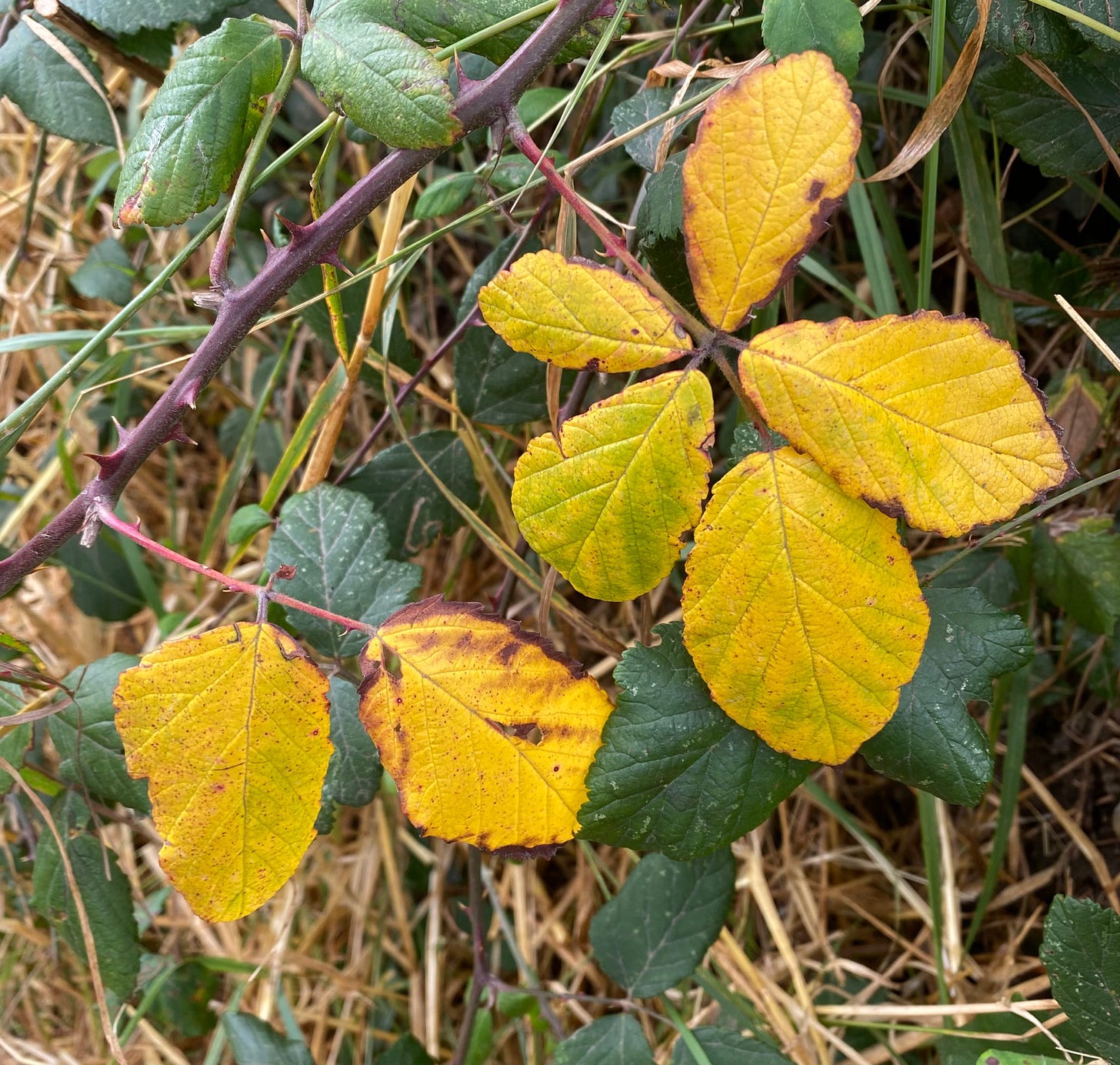


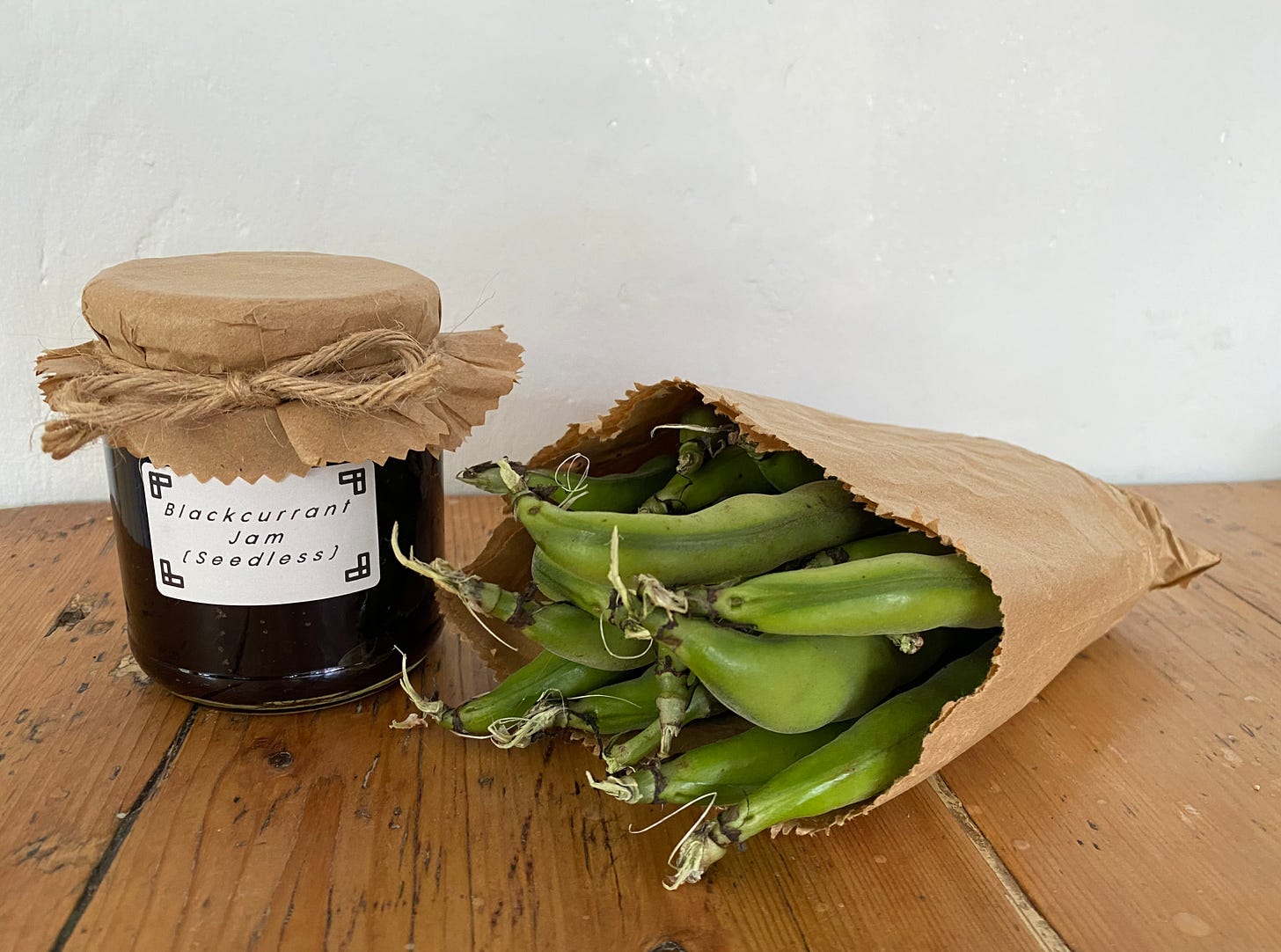
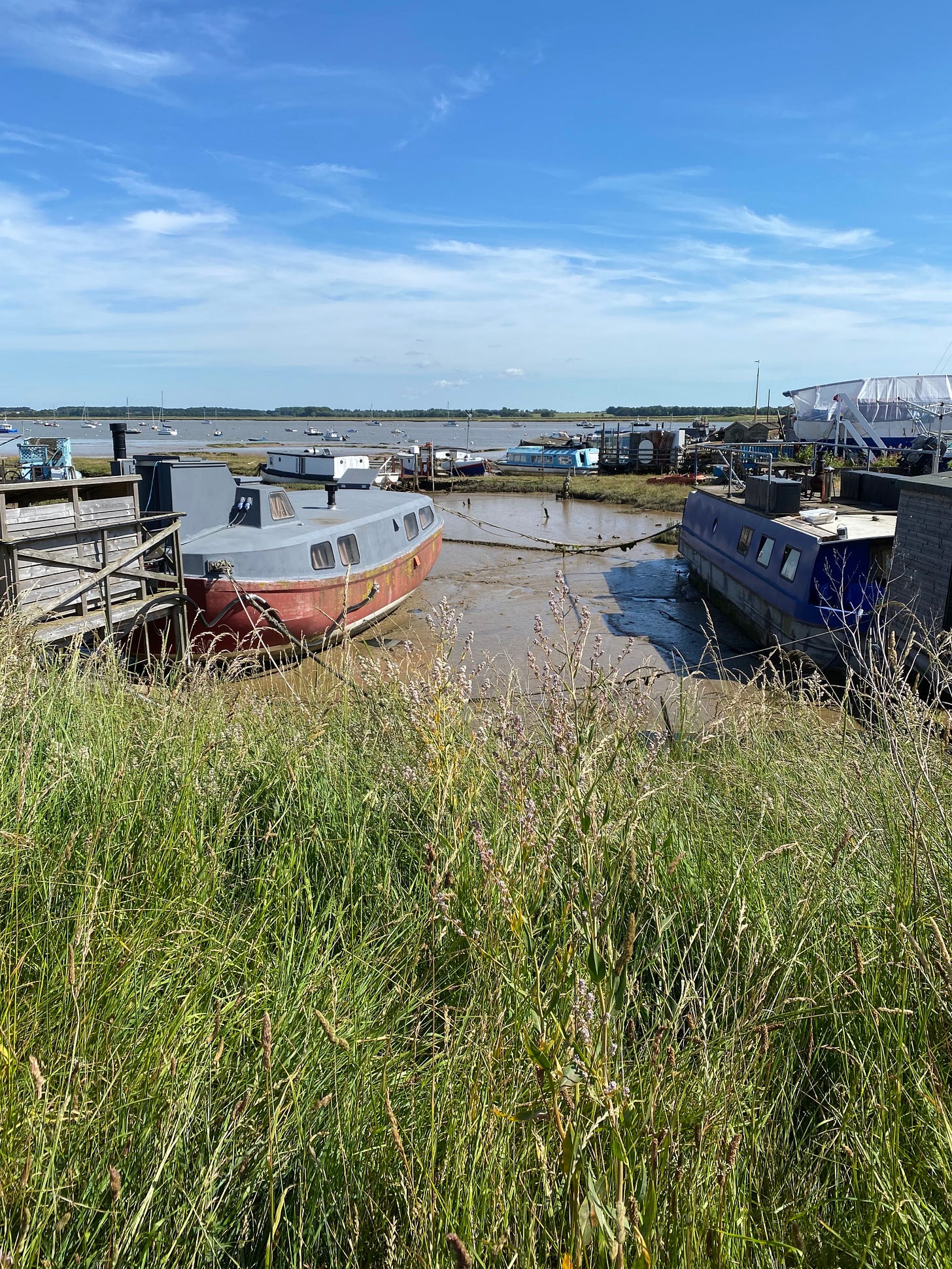

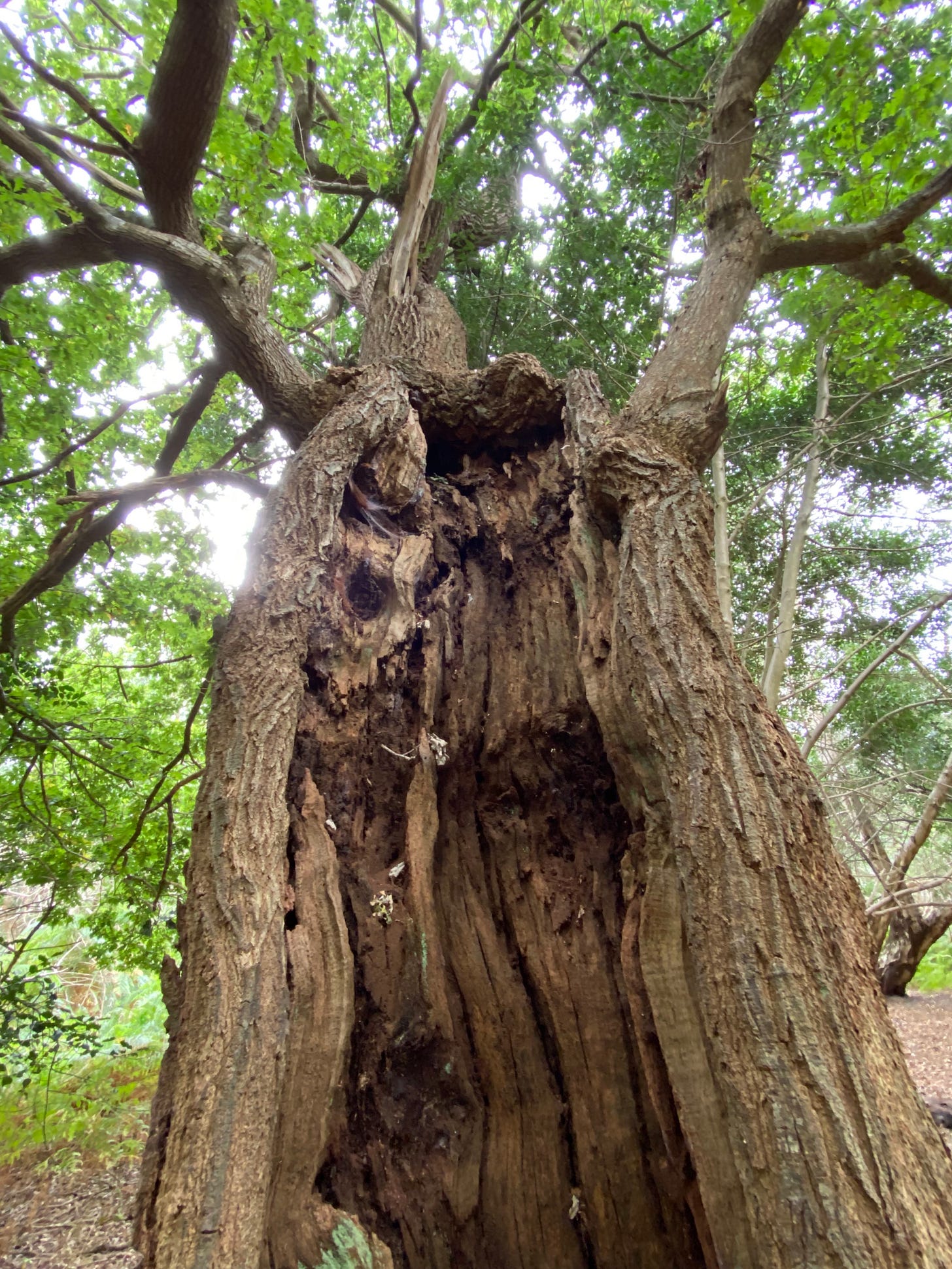
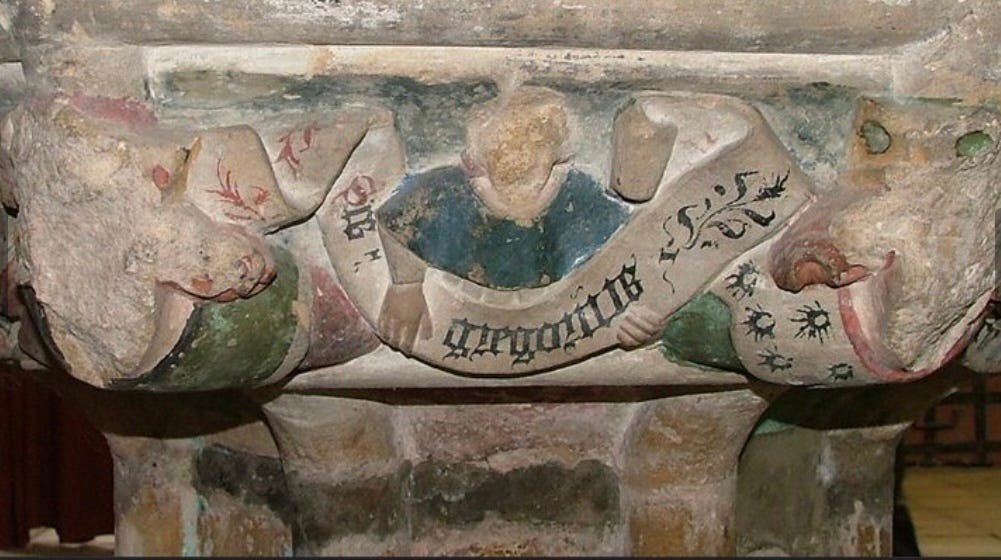

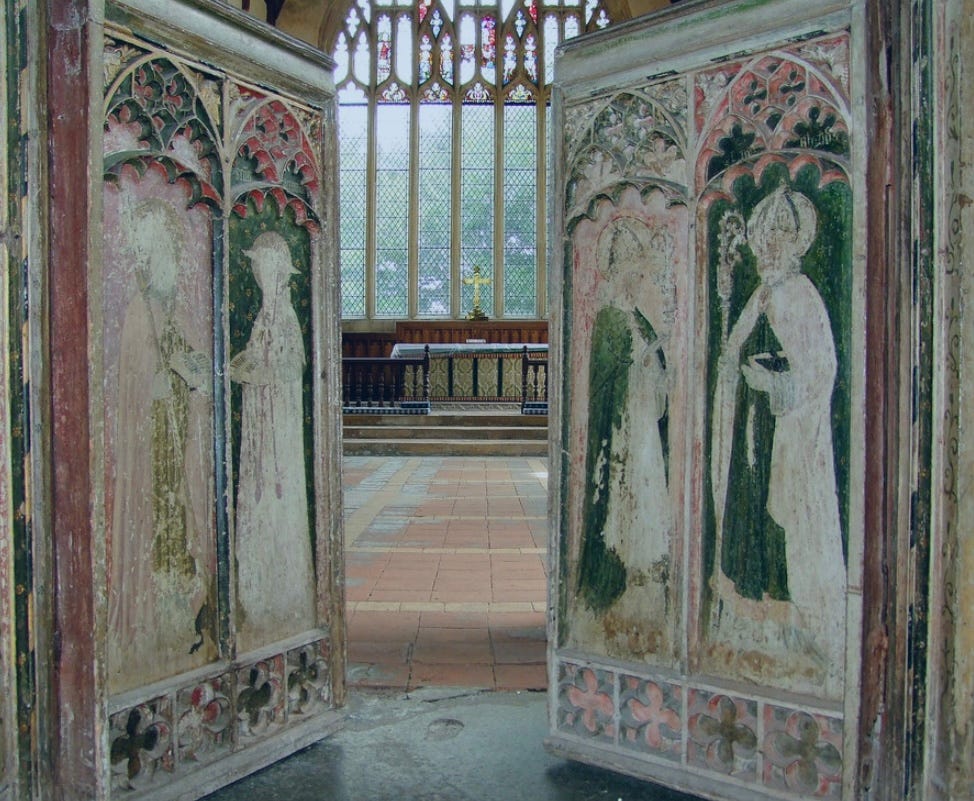

Loved each of the pieces. Your writing gets better and better and has a lovely flow.
Afternoon Imogen. Hope you are well? Just wanted to say how much I loved your piece on St Gregory. Here in Morville my village church that I attend each week, is St Gregory's. It was built in 1118 and was originally part of Morville Priory (a satellite of Shrewsbury Abbey) which is illustrated on the Mappa Mundi in Hereford Cathedral. After Henry VIIIth did his thing of course, all that remains are the church and a couple of the monk's fishponds. One of our elders - Joyce Brick passed away 2 weeks ago aged 101 and 11 months. She died in her sleep - or as I put it 'slipped out the back door when no-one was looking'. Many years ago she made a papier maché St Gregory (about 15" tall) who we fetch out of the vestry where he watches over us as we wash up after coffee, and display him in the church in this, his special week.
Anyway wanted to share that with you. If you find time to Google Morville Church, take a look. We are across the church meadow and backed by Acton Hill which was carved out by a glacier gazillions of years ago. Best wishes and love to you, Elaine xx